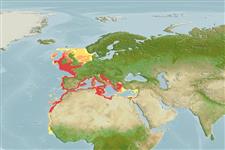>
Eupercaria/misc (Various families in series Eupercaria) >
Cepolidae (Bandfishes) > Cepolinae
Etymology: Cepola: Latin, cepulla = onion.
More on author: Linnaeus.
Environment: milieu / climate zone / rango de profundidad / distribution range
Ecología
marino demersal; rango de profundidad 15 - 400 m. Subtropical; 61°N - 10°N, 18°W - 36°E
Eastern Atlantic: British Isles to north of Senegal, including the Mediterranean.
Length at first maturity / Tamaño / Peso / Age
Madurez: Lm 24.2 range ? - ? cm
Max length : 80.0 cm TL macho / no sexado; (Ref. 27156); common length : 40.0 cm TL macho / no sexado; (Ref. 26999)
Espinas dorsales (total) : 0; Radios blandos dorsales (total) : 67 - 70; Radios blandos anales: 60. Body ribbon-like, gradually tapering to a pointed tail. Large, oblique mouth. Teeth widely spaced on both jaws. First two rays of dorsal fin unsegmented. Caudal fin with median rays longer and free at their tip. Dorsal and anal fins more or less joined to the caudal fin.
Body shape (shape guide): elongated.
Found on sand and mud bottom (Ref. 26999). Lives in vertical burrows but may be found swimming in midwater. Occurs singly or in groups. Feeds mainly on small crustaceans and chaetognaths (Ref. 5984).
Eggs are pelagic.
Quéro, J.-C., 1990. Cepolidae. p. 853-854. In J.C. Quero, J.C. Hureau, C. Karrer, A. Post and L. Saldanha (eds.) Check-list of the fishes of the eastern tropical Atlantic (CLOFETA). JNICT, Lisbon; SEI, Paris; and UNESCO, Paris. Vol. 2. (Ref. 5985)
IUCN Red List Status (Ref. 130435: Version 2025-1)
Threat to humans
Harmless
Human uses
Pesquerías: escaso valor comercial
Herramientas
Special reports
Download XML
Fuentes de Internet
Estimates based on models
Preferred temperature (Referencia
123201): 9.8 - 16.5, mean 11.9 °C (based on 326 cells).
Phylogenetic diversity index (Referencia
82804): PD
50 = 0.5312 [Uniqueness, from 0.5 = low to 2.0 = high].
Bayesian length-weight: a=0.00389 (0.00293 - 0.00517), b=2.41 (2.33 - 2.49), in cm total length, based on LWR estimates for this species (Ref.
93245).
Nivel trófico (Referencia
69278): 3.1 ±0.23 se; based on food items.
Resiliencia (Referencia
120179): Medio, población duplicada en un tiempo mínimo de 1.4-4.4 años (K=0.21; tmax=8).
Fishing Vulnerability (Ref.
59153): Moderate to high vulnerability (55 of 100).
🛈
Climate Vulnerability (Ref.
125649): Moderate vulnerability (38 of 100).
🛈
Nutrients (Ref.
124155): Calcium = 57.7 [33.8, 110.7] mg/100g; Iron = 0.981 [0.583, 1.722] mg/100g; Protein = 18.2 [17.3, 19.1] %; Omega3 = 0.218 [0.131, 0.362] g/100g; Selenium = 47.5 [24.0, 95.1] μg/100g; VitaminA = 12.1 [3.9, 40.0] μg/100g; Zinc = 0.669 [0.462, 0.963] mg/100g (wet weight);
